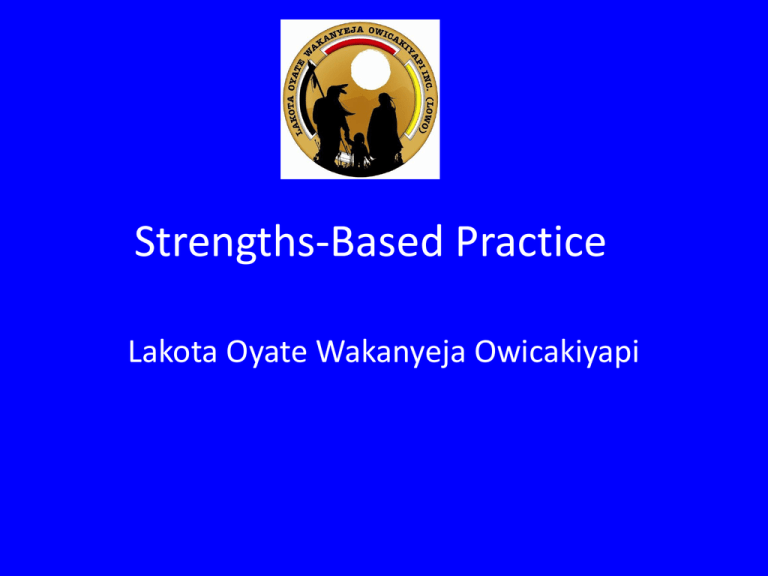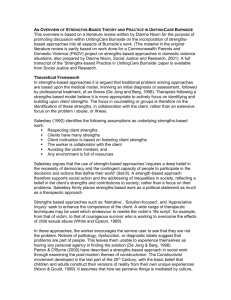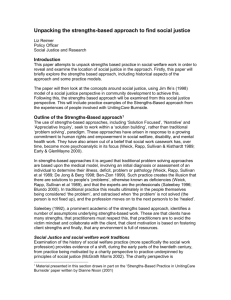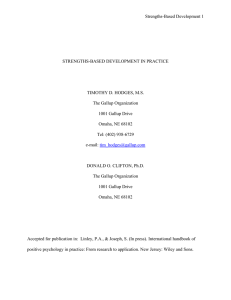Strengths Based Practice
advertisement

Strengths-Based Practice Lakota Oyate Wakanyeja Owicakiyapi AGENDA I. II. III. IV. V. VI. Training norms Goal Objectives Part I- What is strengths-based practice? Part II- Why is strengths-based practice important? Part III- What does strengths-based practice look like at work? VII. Check for Understanding VIII. Closing TRAINING NORMS Please make sure to: - turn off cellular phones and other electronic devices that might create distractions to those around you. - try and remain present in the room the entire time. Breaks are scheduled regularly. TRAINING NORMS Please make sure to: - be respectful of others while they are speaking and limit all side conversations. - respect the unique needs of LOWO’s clients and remember confidentiality is important. GOAL The goal of this training is to provide participants with an experience that will further LOWO’s mission to keep children out of institutions by focusing on support for children to remain with their families, short term foster care, Lakota relative placements and adoption and support through social or court intervention that supports parents taking back the responsibility for their children. Oglala Lakota Practice Model p. 10 OBJECTIVE 1 Participants will be able to recognize the difference between strengths-based practice and deficit (problem) based practice. OBJECTIVE 2 Participants will be able to examine the importance of strengths-based practice and how that impacts the lives of their clients and the larger community. OBJECTIVE 3 Participants will begin to develop strategies for increasing the use of strengths-based practice in their everyday life. THINK, PAIR, SHARE One minute- Think about one of your personal strengths. How does Two minutes- Turn to the person next to you and each of you take a minute to share a bit about your personal strengths. K/W/L What do you know about strengths based practice? What do you want to know about strengths based practice? What did you learn about strengths based practice? PART I- WHAT IS STRENGHTS-BASED PRACTICE? STRENGTHS-BASED PRACTICE “Strength-based service delivery is an approach to providing support and resources to individuals that focuses on identifying and building their assets and skills, to help them create needed change. Strengths are emotional or behavioral skills, competencies, and characteristics that 1) create a sense of personal accomplishment, 2) contribute to satisfying relationships, 3) enhance one’s ability to deal with stress and adversity, and 4) promote moral, social, emotional, skill, and other types of development.” NPC Research and Evaluation (Portland, Oregon) STRENGTHS-BASED PRACTICE “Strengths based practice is a social work practice theory that emphasizes people's self determination and strengths. Strengths based practice is client led, with a focus on future outcomes and strengths that the people bring to a problem or crisis.” Wikipedia STRENGTHS-BASED PRACTICE So, what does this mean to us? Given the little we’ve learned already, how can we begin to define strengths-based practice in our own words? PART II: WHY IS STRENGTHS-BASED PRACTICE IMPORTANT? WHY IT’S IMPORTANT Value: Importance of Human Relationships Ethical Principle: Social workers recognize the central importance of human relationships. Social workers understand that relationships between and among people are an important vehicle for change. Social workers engage people as partners in the helping process. Social workers seek to strengthen relationships among people in a purposeful effort to promote, restore, maintain, and enhance the wellbeing of individuals, families, social groups, organizations, and communities. NASW Code of Ethics WHY IT’S IMPORTANT Value: Dignity and Worth of the Person Ethical Principle: Social workers respect the inherent dignity and worth of the person. Social workers treat each person in a caring and respectful fashion, mindful of individual differences and cultural and ethnic diversity. Social workers promote clients’ socially responsible self-determination. Social workers seek to enhance clients’ capacity and opportunity to change and to address their own needs. Social workers are cognizant of their dual responsibility to clients and to the broader society. They seek to resolve conflicts between clients’ interests and the broader society’s interests in a socially responsible manner consistent with the values, ethical principles, and ethical standards of the profession. NASW Code of Ethics WHY IT’S IMPORTANT Raising children in a high-poverty area creates stressors on families that can magnify perceived problems. Many mainstream providers identify Native clients by their problems, not their potential. The history of child welfare provision among Native families has historically highlighted the difference between dominant culture and indigenous culture. WHY IT’S IMPORTANT Helps clients achieve a goal Helps clients build relationships Helps clients overcome adversity or a crisis Helps clients improve their well-being PART III: STRENGTHS-BASED PRACTICE AT WORK AT WORK Think, Pair, Share Take two minutes to reflect on a particularly challenging family or client you have worked with. Take two minutes to jot down 1) how you accessed this clients strengths OR 2) where you might have missed an opportunity to highlight their strengths. Take four minutes (two minutes each) and turn to the person next to you to share what you just jotted down. Finally, we’ll come back as a large group and take time to talk about your examples more in-depth. AT WORK Where do you already see aspects of strengthsbased practice at work inFamily Preservation Parenting Classes Ceremonies Other areas AT WORK Scenario One Sherry is a nineteen year old who never completed high school. She has been in an off-and-on relationship with the father of her three children (infant, 2 year-old, 4 year-old) for six years now. Although the father provides her with some money, it is not nearly enough to get by so she has a part-time job at Big Bat’s. While she is at work, a cousin watches her children but at times has been unreliable and caused her to miss several shifts. Sherry lives with her sister most of the time but occasionally stays with her stepfather, who lets her and her children use his place while he is gone driving a truck. Last week, while her and her children were at her sister’s, people were partying, a fight broke out, and a neighbor called the police. Sherry has been assigned to your caseload. Where do you begin? AT WORK Scenario Two Sheila and Joe are the parents of four school-age children and have been mandated to take parenting classes. They make every attempt to attend class class each week, but recently they’re started to miss classes and you don’t know why, except that transportations might be an issue. When in class, both actively participate. Last class, when working closely with Joe, you think you might have smelled alcohol on his breath but are unsure and don’t want to accuse him. You also heard from a cousin that while Sheila is at her part-time job and Joe is responsible for watching the children, he takes them to a friend’s house who is a know drug dealer. Where do you begin? CHECK FOR UNDERSTANDING What, if anything, have you learned about strengths based practice that you didn’t know prior to today’s training? What part of strengths based practice is easiest for you to understand? What part is hardest? How will this impact your interactions with the families you work with? CLOSING









